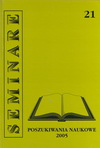Druga noc zbawienia. Próba Abrahama i aqeda Izaaka
According to analysis included in this article and concerning a unity between man and woman described in Gen 2, 24–25 the principal truth arising from
Author(s): Lorenzo SaracenoSubject(s): Christian Theology and Religion
Published by: Towarzystwo Naukowe Franciszka Salezego (TNFS)
Summary/Abstract: The sacrifice of Isaac, aqedah, which account we can find in the chapter 22nd of the Book of Genesis, is an episode in the history of salvation which is widely addressed by Jewish, as well Chris- tian traditions. An example of its application in the Jewish tradition is a „Poem about four night of salvation”, where aqedah is portrayed as the second night. In Christian tradition, the church fathers interpreting Genesis 22 saw in the sacrifice of Isaac the announcement of the Sacrifice of Christ. The author of the text is undertaking the task of interpreting this challenging part of the Bible by analyzing and understanding the meaning of the words in the context of the structure of the text. After reading Genesis 22, the first conclusion that can be reached treats the relationship between God and Abraham as a relationship of dependency and obedience. This relationship almost adopts characteris- tics of a paradox, since as the author claims, „It was not Isaac that was supposed to die, but Abraham in himself, as it is not possible to see God and remain alive, it is not possible to pass the life along other than by dying yourself. It is also where the interdependence between Abraham and God is realized”. Second conclusion points into Christological interpretation of the text. God’s choice directed towards the sacrifice of the Son is portrayed as the source of relationship based on mutual depend- ence, an exchange of the gift of life, which in this case involved our father in faith – Abraham.
Journal: Seminare. Poszukiwania naukowe
- Issue Year: 21/2005
- Issue No: 1
- Page Range: 147-156
- Page Count: 21

